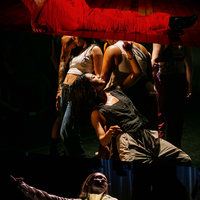Tue 10 May: Laura Moy/Stošija Zrinksi/Bold Mellon Collective

News Story
Laura MoyFootprint in the Snow
Stošija ZrinksiDwelling Place Episode 2
Bold Mellon CollectiveKLAZO
Contemporary circus hits its highest notes when it goes to unexpected places. In Footprint in the Snow, Laura Moy uses a Chinese pole as a site for physical and emotional suspension from the trauma of grief. Instead of the long, glossy lines we usually associate with acrobatics, we get abrupt angles and jolting moments of stillness, Moy’s body held in place by a single limb wrapped around the frame. She fragments things further with spoken word poetry (warped to resemble the surreal ‘backwards talk’ of Twin Peaks) and, later, a pivot to supple, lyrical floorwork. These swerves are disorienting in the way that loss itself is, catapulting our senses from one direction to another. There’s a beautiful tenderness to Tim Lenkiewicz’s dusky amber lighting, and to the way Moy clambers up the pole, exposing rather than veiling the effort behind her aerial feats.
Traffic rumbles, bells toll, and birds tweet in Stošija Zrinski’s Dwelling Place Episode 2, which inhabits a looser, lighter mood. Zrinkski sways to the sounds of the city, slinking through its layered soundscape. Her slow, stretchy movement style feels mellow at times, detached at others; in its coolness, the piece occasionally drifts. But while it wanders, it’s never aimless, the thrums of Xavier Valstin’s sound design ushering the placid choreography to serene heights.
Don’t be fooled by the dismembered body parts in Bold Mellon Collective’sKLAZO; it’s anything but dark. The uplifting duet highlights the turbulence of Tourette’s Syndrome, its dancers (both of whom have the condition) using springy bursts of dance to relay their complicated relationship with self-control. Choreographer Maddie Mellon is especially spirited, giggling along as she fidgets and tumbles to Kay Rowan’s soulful score. It’s a welcome example of how art exploring disability doesn’t have to be po-faced.
Sara Veale
Laura Moy mesmerises from start to finish. She plays spoken word backwards and situates herself among lopsided furniture to communicate a completely upturned world. While she takes “upturned” to the extreme with her strength on the pole, it’s her focus on her surroundings which lures me in. It’s emotional to watch the pole oscillate between offering comfort and challenge. Moy navigates the pole seamlessly, arching around it in either surrender or defeat, though her costume and the sound of her breath frames her as an everyday person with everyday issues. I only wonder how the spoken word could have been more intertwined with the pole performance.
Stošija Zrinski walks on stage almost angrily to open Dwelling Place Episode 2, refusing to acknowledge the audience. Xavier Velastin’s soundscape establishes an urban setting, which feels more real as Zrinski follows the sounds with her gaze. Unfortunately, this immersion is shattered by a sudden turn that begins the dance. Reminiscent of contemporary class material, the movement isn’t often interesting enough to stand up for itself as a solo. I wonder if this was a choice related to her character, who seems unaware or unconcerned by the context of performance? As she finds stillness on the floor, I’m left waiting for something else.
It’s refreshing to watch a performance that makes me smile within the first minutes. The dancers of Bold Mellon Collective enter the space running, rolling, cartwheeling and laughing at themselves in contagious joy. This disarms the audience and lets us into their world. Whether communicating with each other or mimicking parts of statues that hang from above, the dancers have a playfulness at first which is funny in parts and heart-warming in others. As the work progresses, the dancers share their vulnerability and compassion – a switch in tone that is enhanced and romanticised by the music of Kay Rowan. KLAZO prompts thoughts about how we understand others; this is an outstanding performance of support and acceptance.
Luke Hodkinson


